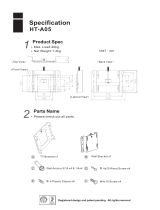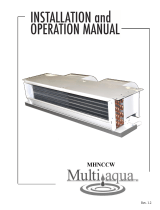
Manual 2100-628
Page 18 of 24
SEQUENCE OF OPERATION
COOLING – Circuit R-Y makes at thermostat pulling
in compressor contactor, starting the compressor and
outdoor motor. (See NOTE on previous page under
Condenser Fan Operation if equipped with Low Ambient
Control.) The G (indoor motor) circuit is automatically
completed by the thermostat on any call for cooling
operation or can be energized by manual fan switch
on subbase for constant air circulation. On a call for
heating, circuit R-W1 make at the thermostat pulling in
heat contactor for the strip heat and blower operation.
On a call for second stage heat, R-W2 makes bringing
on second heat contactor, if so equipped.
COMPRESSOR CONTROL MODULE
The compressor control module is standard on all
models covered by this manual. The compressor
control module is an anti-short cycle/lockout timer with
high and low pressure switch monitoring and alarm
relay output.
Adjustable Delay On Make And Break Timer
On initial power up or anytime power is interrupted to
the unit, the delay on make period begins, which will
be 2 minutes plus 10% of the delay on break setting.
When the delay on make is complete and the high
pressure switch and low pressure switch is closed, the
compressor contactor is energized. Upon shutdown,
the delay on break timer starts and prevents restart
until the delay on break and delay on make periods
have expired.
During routine operation of the unit with no power
interruptions, the compressor will operate on demand
with no delay.
High Pressure Switch and Lockout Sequence
If the high pressure switch opens, the compressor
contactor will de-energize immediately. The lockout
timer will go into a soft lockout and stay in soft lockout
until the high pressure switch closes and the delay on
break time has expired. If the high pressure switch
opens again in this same operating cycle, the unit will
go into manual lockout condition and the alarm relay
circuit will energize. Recycling the wall thermostat
resets the manual lockout.
Low Pressure Switch, Bypass, and Lockout Sequence
If the low pressure switch opens for more than 120
seconds, the compressor contactor will de-energize
and go into a soft lockout. Regardless the state of the
low pressure switch, the contactor will reenergize after
the delay on make time delay has expired. If the low
pressure switch remains open, or opens again for longer
than 120 seconds, the unit will go into manual lockout
condition and the alarm relay circuit will energize.
Recycling the wall thermostat resets the manual
lockout.
Alarm Relay Output
Alarm terminal is output connection for applications
where alarm relay is employed. This terminal is
powered whenever the compressor is locked out due to
HPC or LPC sequences as described.
NOTE: Both high and low pressure switch controls are
inherently automatic reset devices. The high
pressure switch and low pressure switch cut
out and cut in settings are fixed by specific air
conditioner unit model. The lockout features,
both soft and manual, are a function of the
Compressor Control Module.
ADJUSTMENTS
Adjustable Delay on Make and Delay on Break Timer
The potentiometer is used to select Delay on Break
time from 30 seconds to 5 minutes. Delay on
Make (DOM) timing on power-up and after power
interruptions is equal to 2 minutes plus 10% of Delay
on Break (DOB) setting:
0.5 minute (30 seconds) DOB = 123 second DOM
1.0 minute (60 seconds) DOB = 126 second DOM
2.0 minute (120 seconds) DOB = 132 second DOM
3.0 minute (180 seconds) DOB = 138 second DOM
4.0 minute (240 seconds) DOB = 144 second DOM
5.0 minute (300 seconds) DOB = 150 second DOM
During routine operation of the unit with no power
interruptions, the compressor will operate on demand
with no delay.
Typical Settings for Dual Unit Installation:
Unit 1: DOB set at 2 minutes; DOM is 132 seconds
Unit 2: DOB set at 4 minutes; DOM is 144 seconds
PRESSURE SERVICE PORTS
High and low pressure service ports are installed on
all units so that the system operating pressures can be
observed. A cooling pressure table can be found on
page 22.






















